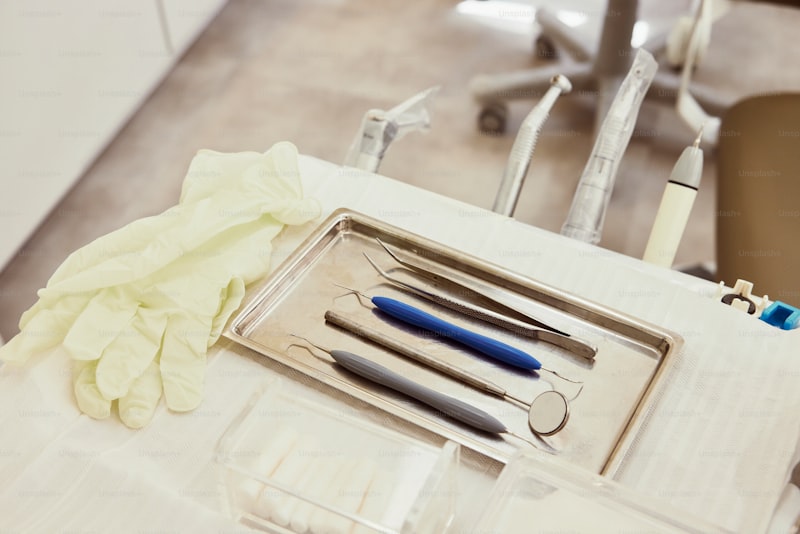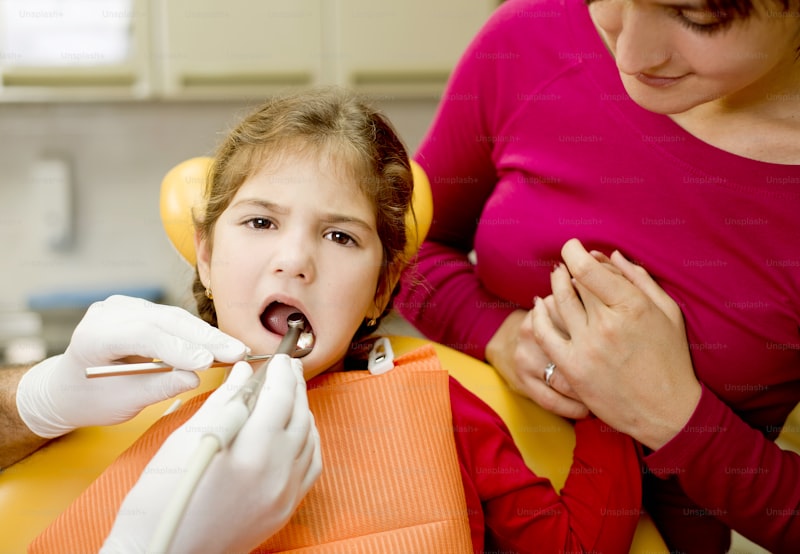One of the most common dental issues is a sudden toothache or increased sensitivity. Begin by rinsing your mouth with warm water and gently floss around the affected tooth to remove any trapped debris. Over-the-counter pain relievers like ibuprofen can help alleviate discomfort temporarily. Applying a cold compress to the outside of your cheek near the painful area may also provide relief.
If you chip or break a tooth, rinse your mouth with warm water to clean the area. Save any broken tooth fragments if possible. If there is bleeding, apply a piece of gauze to the area for about 10 minutes or until the bleeding stops. Use a cold compress on the outside of the mouth near the injury to minimize swelling and relieve pain.
A knocked-out tooth requires immediate action for the best chance of saving it. Handle the tooth by the crown (the chewing surface) rather than the root. Gently rinse it with water, but do not scrub or remove any attached tissue fragments. Try to reinsert the tooth into its socket if possible. If not, place it in a container of milk or saliva to keep it moist. Seek dental care immediately, ideally within 30 minutes, as this significantly increases the likelihood of successful re-implantation.
If a filling or crown falls out, clean the affected tooth and the inside of the crown thoroughly. You can temporarily reattach a crown using dental adhesive or temporary dental cement available at pharmacies. Avoid chewing on the repaired tooth until you can see your dentist.
An abscess is a serious condition requiring prompt attention. It presents as a painful, swollen area around a tooth, and may cause fever or a bad taste in the mouth. Rinse your mouth with mild salt water several times a day to help draw out the infection. Use over-the-counter pain relievers and seek dental care immediately, as abscesses can lead to serious complications if left untreated.
Always have the contact information for your dentist readily available, especially during off-hours. Consider creating a dental emergency kit with essentials like sterile gauze, a small container with a lid, dental adhesive, and pain relievers. Regular dental check-ups can also help prevent emergencies by identifying potential issues early.
By staying prepared and knowing how to respond to common dental emergencies, you can effectively manage unexpected situations until you can see your dentist for proper treatment.
Essential Guide: Handling Dental Emergencies Safely at Home
One of the most common dental emergencies is a toothache. When pain strikes, it’s often a sign of an underlying issue such as decay, infection, or gum disease. Start by gently rinsing your mouth with warm water and using dental floss to remove any trapped food particles that may be causing irritation. Over-the-counter pain relievers like ibuprofen can help manage the pain until you can see your dentist.

If you’ve chipped or broken a tooth, rinse your mouth with warm water to clean the area. If there’s bleeding, apply gentle pressure with a piece of gauze or a clean cloth. To protect your tongue and cheek from any sharp edges, cover the broken tooth with dental wax or sugarless gum. Avoid chewing on that side of your mouth and stick to soft foods until you can get professional help.
Losing a filling or crown can be uncomfortable, but there are temporary measures you can take. Try placing dental cement, which can be found at most pharmacies, into the cavity left by the lost filling or crown. This will protect the exposed tooth until you’re able to see your dentist for a more permanent solution.
Perhaps one of the most urgent dental emergencies is having a tooth knocked out. If this happens, carefully pick up the tooth by the crown (the chewing surface), avoiding touching the root. Rinse the tooth gently with water if it’s dirty, but do not scrub or remove any attached tissue fragments. Try to reinsert the tooth into its socket and hold it in place by gently biting down on a clean cloth or gauze. If you can’t reinsert the tooth, place it in a container of milk or saliva—this helps preserve the tooth until you can see your dentist.
While these tips can help manage dental emergencies at home, it’s crucial to seek professional dental care as soon as possible. Dentists have the expertise and tools to properly assess and treat dental emergencies to prevent further damage and ensure your oral health is restored.
Handling dental emergencies at home requires quick thinking and knowing the right steps to take. By being prepared and acting promptly, you can ease discomfort and safeguard your dental health until you can receive professional treatment.
Expert Tips: What to Do During Dental Emergencies Without a Dentist
Firstly, if you experience a toothache, rinse your mouth with warm water and gently floss around the affected tooth to ensure there’s no debris causing discomfort. Over-the-counter pain relievers like ibuprofen can help manage pain temporarily. Avoid placing aspirin directly on the gums or tooth, as this can cause burns.
In cases where a tooth is knocked out due to trauma, it’s crucial to act swiftly. Hold the tooth by the crown (top part), rinse it gently with water if dirty (avoid scrubbing), and try to reinsert it into the socket, if possible. If reinsertion isn’t feasible, store the tooth in milk or a tooth preservation product designed for emergencies until you can reach a dentist. Time is critical in saving a knocked-out tooth, so seek professional care immediately.
For a broken or chipped tooth, rinse your mouth with warm water to clean the area. If there’s bleeding, apply gauze to the affected area with gentle pressure. Save any broken tooth fragments and rinse them with water. Again, over-the-counter pain relievers can help manage discomfort until you see a dentist.
When dealing with a lost filling or crown, temporary dental cement (available at pharmacies) can be used to cover the exposed tooth surface until you can visit your dentist. Avoid chewing on the affected side to prevent further damage or discomfort.
Lastly, if you experience swelling in your mouth or face accompanied by a fever, it could indicate an infection that requires immediate attention. Rinse your mouth with warm salt water and use a cold compress on the outside of your cheek to reduce swelling. Seek emergency dental care as soon as possible.
Emergency Dental Care: DIY Steps to Manage Common Issues at Home
A toothache can strike unexpectedly and leave you feeling miserable. One of the first things you can do is rinse your mouth with warm water and gently floss around the affected tooth to ensure no food particles are aggravating the pain. Over-the-counter pain relievers like ibuprofen can provide temporary relief until you can get professional care.
Accidents happen, and a knocked-out tooth can be frightening. If this occurs, handle the tooth by the crown (top part), not the root. Rinse it gently with water, but do not scrub it or remove any attached tissue. Try to place the tooth back in its socket if possible, or store it in a container of milk until you can reach a dentist. Time is critical in saving a knocked-out tooth, so seek professional help immediately.
A cracked tooth can vary in severity, from minor fractures to more serious splits. Rinse your mouth with warm water to keep it clean. If there is swelling, apply a cold compress on the outside of your cheek. Avoid chewing on that side of your mouth and stick to soft foods until you can see your dentist.
Losing a filling or crown can expose sensitive parts of your tooth and cause discomfort. While waiting for professional treatment, you can apply a small amount of dental cement (available at pharmacies) to cover the exposed area temporarily. Avoid chewing on that side of your mouth and steer clear of very hot or cold foods and drinks.
Abscesses are serious infections that can cause throbbing pain, swollen glands, and even fever. Rinse your mouth with mild saltwater several times a day to draw out the infection and relieve discomfort. It’s crucial to see a dentist promptly to prevent the infection from spreading.
Emergencies can happen when we least expect them, but being prepared with these DIY tips can help you manage dental issues at home until professional help is available. Remember, these tips are temporary solutions, and it’s essential to seek dental care as soon as possible to prevent further complications.
Your Quick Response Guide to Dental Emergencies When Professional Help Isn’t Available

A sudden, throbbing toothache can be excruciating. Begin by gently rinsing your mouth with warm water to clean the area. Use dental floss to remove any food particles that may be causing discomfort. If swelling is present, apply a cold compress to the outside of your cheek. Over-the-counter pain relievers like ibuprofen can help manage pain until you can see a dentist.
Losing a filling or crown can expose sensitive tooth tissue, leading to pain and discomfort. While awaiting professional care, try placing the crown back over the tooth using dental adhesive or temporary dental cement, available at pharmacies. Avoid chewing on the affected side and stick to soft foods to prevent further damage.
A broken or cracked tooth requires immediate attention to prevent infection or further damage. Rinse your mouth with warm water to clean the area. If there’s swelling, apply a cold compress externally. Avoid eating hard or sticky foods, and use dental wax or sugar-free gum to cover any sharp edges that may irritate your tongue or gums.
If a tooth gets knocked out, time is critical for successful re-implantation. Hold the tooth by the crown (the chewing surface) and rinse it gently with water. Try to reinsert it back into the socket if possible, ensuring it’s facing the right way. If reinsertion isn’t feasible, place the tooth in a container of milk or saliva—never water—and seek dental care immediately.
An abscessed tooth or gum can cause intense pain and requires prompt attention. Rinse your mouth with mild saltwater to help draw out pus and reduce swelling. Over-the-counter pain relievers can offer temporary relief, but it’s essential to see a dentist as soon as possible to drain the abscess and prescribe antibiotics if necessary.
If something gets stuck between your teeth, use dental floss to gently remove it. Avoid using sharp objects or excessive force, as these can damage your gums or teeth. If flossing doesn’t work, try rinsing your mouth with warm water or using an interdental brush to dislodge the object. Seek professional help if the object remains stuck or causes pain.
Being prepared for dental emergencies when professional help isn’t available can mitigate discomfort and prevent complications. Remember, these measures are temporary solutions. It’s crucial to seek professional dental care as soon as possible to address the underlying issue and ensure long-term oral health.
Home Remedies: Effective Solutions for Immediate Dental Relief
One of the most accessible remedies is rinsing your mouth with warm salt water. This simple solution helps to cleanse the affected area and reduce inflammation. Just dissolve a teaspoon of salt in a glass of warm water, swish it around your mouth for about 30 seconds, and then spit it out. Repeat as needed throughout the day.
Another popular remedy is applying a cold compress to the outside of your cheek near the painful area. Cold can help numb the nerves and reduce swelling, providing temporary relief from the discomfort.
For those who prefer natural remedies, clove oil is a go-to option. Clove oil contains eugenol, a natural anesthetic and antibacterial agent. Simply soak a cotton ball with a few drops of clove oil and apply it directly to the affected tooth or gum area. Be cautious not to apply too much as it can cause irritation.
Alternatively, a tea bag can also come in handy. Black tea contains tannins, which can help reduce swelling and provide relief from pain. Steep a tea bag in boiling water for a few minutes, allow it to cool slightly, and then hold it against the affected area.
If you have some in your kitchen, garlic can be surprisingly effective due to its natural antibacterial properties. Crush a garlic clove to create a paste, add a pinch of salt, and apply it directly to the painful area. Garlic may cause a slight burning sensation, but it can help alleviate pain and fight oral bacteria.
Lastly, maintaining good oral hygiene practices such as brushing and flossing regularly can prevent future dental problems and reduce the likelihood of experiencing sudden discomfort.
By using these simple yet effective home remedies, you can often find immediate relief from dental pain until you’re able to see a dentist for a more permanent solution. Take care of your oral health, and remember to consult a dental professional if pain persists or worsens.
Be Prepared: How to Build Your At-Home Dental Emergency Kit
First off, every good dental emergency kit starts with the basics. You’ll want to include dental floss, because sometimes a pesky popcorn kernel can cause major discomfort. A small mirror is handy for checking hard-to-see areas, especially if something feels stuck between your teeth. Tweezers can be useful for carefully removing objects or debris.
Pain relief is crucial. Ibuprofen or acetaminophen can help manage discomfort until you can get professional care. An over-the-counter dental cement can temporarily hold a loose crown or filling in place. Keep in mind, though, these are temporary fixes and you should see your dentist as soon as possible.
Antiseptic oral gel or rinse can help soothe gum irritation or mouth sores. Hydrogen peroxide diluted with water can act as an antiseptic mouthwash in emergencies. Don’t forget to include sterile gauze pads for controlling bleeding from a knocked-out tooth or injury.
It’s also wise to have your dentist’s contact information readily available, along with any medical conditions or allergies you have. This ensures that emergency responders have all the necessary information if you need to seek urgent care.
In essence, your at-home dental emergency kit should be like a first-aid kit tailored for dental mishaps – simple, effective, and ready to tackle unexpected challenges with ease. By being prepared, you can alleviate discomfort and handle dental emergencies with confidence until professional help is available.
Managing Tooth Pain: DIY Techniques and When to Seek Professional Care
One of the quickest remedies is a saltwater rinse. It’s as simple as mixing warm water with salt and swishing it around in your mouth. This can help reduce swelling and clean out any lingering debris that might be aggravating your tooth.
If you’re more of a hands-on person, applying a cold compress to the outside of your cheek can work wonders. The cold helps numb the area, providing temporary relief from that persistent ache.
Another trick up your sleeve could be over-the-counter pain relievers like ibuprofen or acetaminophen. These can help alleviate the pain until you’re able to get professional treatment.
But hold up! While these DIY hacks can offer some relief, they’re not permanent solutions. If your tooth pain persists for more than a couple of days, or if you notice signs of infection like swelling or fever, it’s time to pick up the phone and call your dentist. They have the expertise and tools to diagnose the underlying issue and provide you with the proper treatment.
Remember, managing tooth pain is all about knowing when to take matters into your own hands and when to leave it to the pros. By being proactive and staying on top of your oral health, you can keep those pesky toothaches at bay and rock your smile with confidence.
Frequently Asked Questions
How can I relieve a knocked-out tooth at home?
Learn how to relieve a knocked-out tooth at home with simple steps like gently rinsing the tooth, placing it back into the socket if possible, or storing it in milk or saliva to keep it moist before seeing a dentist immediately.
What should I do if I have a toothache at home?
Learn how to manage toothache at home with effective remedies and immediate relief techniques.
What are immediate steps for a broken tooth at home?
Learn how to manage a broken tooth at home with immediate steps to alleviate pain and prevent further damage. Follow these steps: 1. Rinse mouth with warm water. 2. Apply a cold compress to reduce swelling. 3. Use dental wax or sugar-free gum to cover sharp edges. 4. Take over-the-counter pain relievers as needed. 5. Contact a dentist for further evaluation and treatment.
How do I manage a lost filling or crown at home?
Learn how to manage a lost filling or crown at home with our concise guide. Discover step-by-step instructions to temporarily address discomfort and protect your tooth until you see a dentist.
What home remedies help with dental pain and swelling?
Discover effective home remedies to alleviate dental pain and swelling naturally. Learn practical solutions that provide relief without medication.


